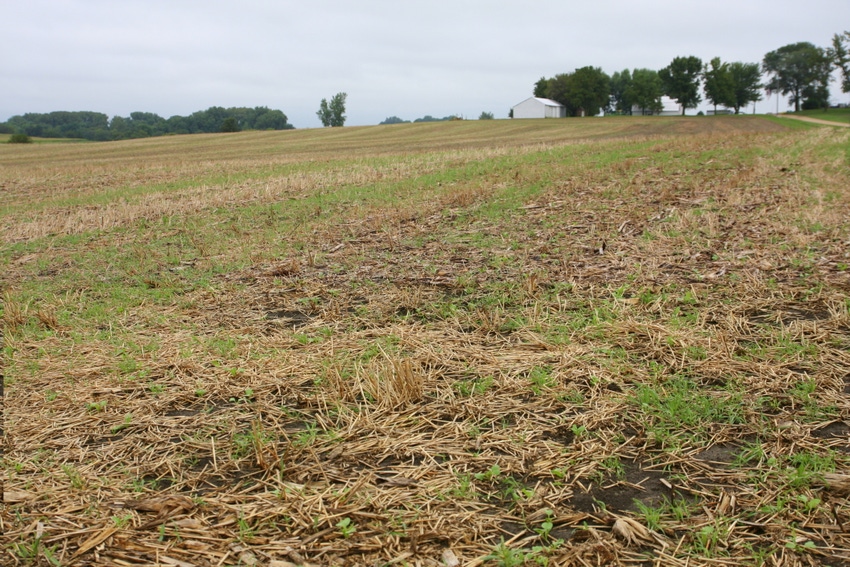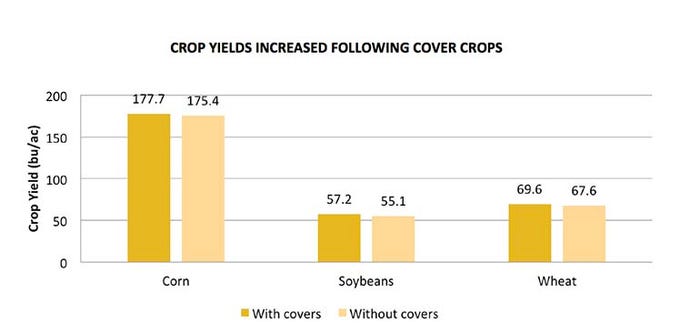
The use of cover crops is becoming a more mainstream practice as a new farmer survey reveals acreage planted in cover crops has nearly doubled over the past five years. With the increased use, tangible benefits to farmers are also on the rise as the survey revealed farmers reported increased yields of corn, soybeans and wheat and saw an improvement in the control of herbicide-resistant weeds.
The survey of 2,012 farmers was conducted by the Conservation Technology Information Center (CTIC) with help from Purdue University and funding support from USDA’s Sustainable Agriculture Research and Education (SARE) program and the American Seed Trade Association (ASTA).
Survey participants—88% of whom use cover crops—reported that after cover crops:
Corn yields increased an average of 2.3 bushels per acre, or 1.3%;
Soybean yields increased 2.1 bushels per acre, or 3.8%;
Wheat yields increased 1.9 bushels per acre, or 2.8%.
The last USDA Census of Agriculture found that farmers planted more than 10 million acres of cover crops in 2012. The new agricultural census, which will begin this fall, is likely to find several million additional acres of cover crops planted in 2017.
The average number of acres of cover crops planted per respondent has also been on a steady rise. Farmers reported planting a mean of 400 acres of cover crops each in 2016, up from 334 in 2015, 281 in 2014, 245 in 2013 and 217 in 2012. The rise is projected to continue, with respondents planning to plant an average of 451 acres of cover crops each in 2017.
It is significant to note that the steady increase over the last three years has occurred despite very low commodity prices. That could reflect a strong and growing recognition of the value of cover crops—a recognition that motivates these farmers to invest in them even when margins are low, the survey report noted.

Chad Watts, executive director of CTIC in West Lafayette, Ind., explained in questioning why farmers are not using cover crops, concerns over profit margins did come into play. However, for those farmers using the practice, they reported low commodity prices have little impact on their decision to plant cover crops.
Soil health remains a top reason for farmers to begin using cover crops, although once started multiple benefits encourage continued use.
Rob Myers, regional director of extension programs for North Central SARE at the University of Missouri, explained the survey found 85% of the farmers who used cover crops said they have seen improvements in soil health.
Though building soil is a long-term process, more than half the farmers reported that soil improvements began appearing in less than two years. An additional 21% said improvements appeared in 2 to 3 years, 5% in 4 to 5 years, and 19% reported waiting 5 years or more before seeing benefits in soils on their farm. Just 2% said they have not seen benefits to their soils from cover crops.
“That reflects long-term thinking and a growing understanding of the enduring value that cover crops deliver,” Myers said. If farmers use cover crops for two to three years, they’re “highly likely to continue using them,” he added.
Myers added that 69% of the respondents said cover crops always or sometimes improved control of herbicide-resistant weeds. That is a significant number, he noted, as a majority of respondents—59%—reported having herbicide-resistant weeds in at least some of their fields.
“Whether using cereal rye, annual ryegrass, other cover crop species or mixes, cover crops are clearly a promising and powerful component of a weed control toolbox in desperate need of efficacious tools. Here again, research and education could boost a key benefit of cover crops and perhaps reduce the pressure on some struggling herbicides,” the report noted.

Crop insurance
This year’s survey included questions exploring the impact of crop insurance rules and actions on the adoption of cover crops, including the use of inter-seeding. Inter-seeding cover crops into corn or other crops early in the summer is becoming an increasingly common practice. Whether flown on, broadcast or seeded with a high-clearance drill, inter-seeding of cover crops is intended to give the covers a head start on establishment during the growing season.
In general, cover crops have become more widely accepted by crop insurance agents. Among 1,106 cover crop users who answered the question, 82% selected the statement “My insurance agent is OK with me using cover crops.” Just 3% said their insurance agent was resistant to their use of cover crops at first but has changed his or her position, and 4% stated that their insurance agent continues to be resistant to their use of cover crops.
The survey dug more deeply into what respondents have experienced or what they perceive in the field about confusion surrounding cover crops and crop insurance. Among farmers who selected a statement from a group of options on the topic, 70% said they had not heard of anyone having problems with crop insurance rules while using cover crops. Eighteen percent selected, “It is my perception that there are other farmers in my area who do not use cover crops because of potential problems with crop insurance,” while 9% said they no longer use crop insurance or have considered dropping it, and 3% perceived that other farmers have foregone crop insurance because of cover crop rules.
The complete 2017 Cover Crop Survey Report is available online at www.sare.org/CoverCropSurvey.
About the Author(s)
You May Also Like




